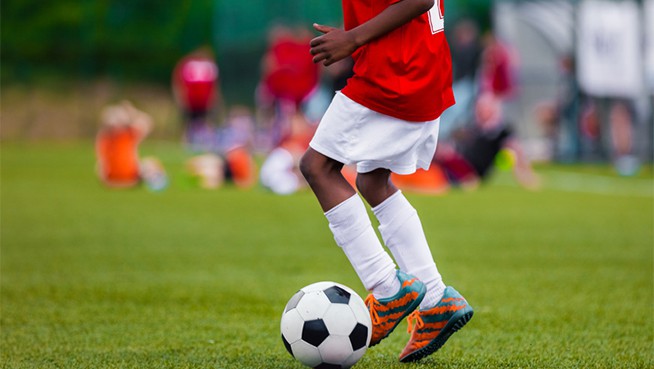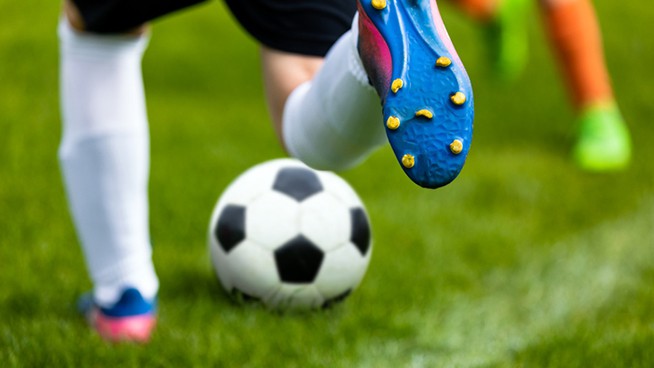Never Fumble Again: How to Carry a Football
Fumbling is bad. Very bad. Repeatedly losing the football and giving the opposing team a chance to recover it will quickly land you on the bench—no matter how good a runner you are. But fumbles can be avoided. Like any other skill, ball security is rooted in fundamentals. If you know how to hold the ball correctly, you can greatly reduce your risk of fumbles. Carrying the football effectively comes down to a basic set of principles known as the “five points of contact”. Mastering the five points of contact will help you keep the ball in your hands while you’re making plays for your team.
RELATED: Strengthen Your Grip on the Football with 7 Moves
The five points of contact refer to the areas of the body that touch the football when you carry it properly. Knowing how to carry the football is as simple as learning the five points of contact, getting comfortable using them, and putting them into action during drills, practices and games.
1. Lower Bicep
This is the first point of contact. When you’re positioning the ball to carry it, place the back tip into the pit of your inner elbow. When you bend your arm, the back tip of ball will move up slightly and press firmly into the inside part of your lower biceps. Protecting the back tip of the ball is incredibly important, because an exposed back tip gives pursuing tacklers a spot to punch the ball or pry it from your grip.
2. Forearm
The next point of contact is the forearm. The inside of your forearm should support the bottom side of the football. Bend your arm at an acute angle while carrying the ball to keep pressure into your forearm and bicep. Protecting the bottom side of the football is hugely important, because exposing this area leaves you vulnerable to having the ball punched out.
RELATED: Catch the Football Every Time
3. Palm
The next point of contact is the palm. There should be absolutely no space between your palm and the surface of the football, and you should grip the ball like a vise.
4. Fingers
Your fingers should form an “eagle claw” grip, with the nose of the football between your index and middle fingers. Each finger (and your thumb) should actively push against the ball for added security. Exposing the nose of the ball is terrible form, and will leave you susceptible to strips and incidental contact that can jar the ball loose.
5. Chest
The final point of contact should be your chest. The inside of the ball should be tightly secured against your chest while you hold the football in a “high and tight” position—making it extremely difficult for defenders to get their hands on it.
When executed correctly, the five points of contact ball-carrying method is virtually unbreakable. But the only way you’ll get comfortable carrying the ball this way is to practice. It’s one thing to perform the “5 Points of Contact” while standing in place, but in a game you’ll need to do it on the fly, when defenders are actively trying to force a fumble. Here’s a simple drill to perform with a teammate that can greatly help you improve your ball security
Basic “Ball Security” Drill
- One player carries the football using the “5 Points of Contact.”
- Another player stands directly behind him.
- To start the drill, the ballcarrier runs at about 80% in a straight line.
- Once the ballcarrier runs about 5 yards, the second player runs to get next to him.
- Once the second player catches up, he begins trying to get the football away from the ballcarrier, doing everything short of tackling or intentionally injuring the ball carrier—punching the ball, stripping the ball, prying the ballcarrier’s fingers off the ball—everything a defender would do to force a fumble.
- The ballcarrier must maintain the 5 points of contact and a high and tight ball position, holding on to the ball for dear life and maintaining good ball security.
- Once the two players jog a total of 20 yards, the ballcarrier switches hands and performs the drill again. Each player should get two reps of carrying the ball in each arm before the drill concludes.
RELATED: All of the Football Positions, Explained
RECOMMENDED FOR YOU
Never Fumble Again: How to Carry a Football
Fumbling is bad. Very bad. Repeatedly losing the football and giving the opposing team a chance to recover it will quickly land you on the bench—no matter how good a runner you are. But fumbles can be avoided. Like any other skill, ball security is rooted in fundamentals. If you know how to hold the ball correctly, you can greatly reduce your risk of fumbles. Carrying the football effectively comes down to a basic set of principles known as the “five points of contact”. Mastering the five points of contact will help you keep the ball in your hands while you’re making plays for your team.
RELATED: Strengthen Your Grip on the Football with 7 Moves
The five points of contact refer to the areas of the body that touch the football when you carry it properly. Knowing how to carry the football is as simple as learning the five points of contact, getting comfortable using them, and putting them into action during drills, practices and games.
1. Lower Bicep
This is the first point of contact. When you’re positioning the ball to carry it, place the back tip into the pit of your inner elbow. When you bend your arm, the back tip of ball will move up slightly and press firmly into the inside part of your lower biceps. Protecting the back tip of the ball is incredibly important, because an exposed back tip gives pursuing tacklers a spot to punch the ball or pry it from your grip.
2. Forearm
The next point of contact is the forearm. The inside of your forearm should support the bottom side of the football. Bend your arm at an acute angle while carrying the ball to keep pressure into your forearm and bicep. Protecting the bottom side of the football is hugely important, because exposing this area leaves you vulnerable to having the ball punched out.
RELATED: Catch the Football Every Time
3. Palm
The next point of contact is the palm. There should be absolutely no space between your palm and the surface of the football, and you should grip the ball like a vise.
4. Fingers
Your fingers should form an “eagle claw” grip, with the nose of the football between your index and middle fingers. Each finger (and your thumb) should actively push against the ball for added security. Exposing the nose of the ball is terrible form, and will leave you susceptible to strips and incidental contact that can jar the ball loose.
5. Chest
The final point of contact should be your chest. The inside of the ball should be tightly secured against your chest while you hold the football in a “high and tight” position—making it extremely difficult for defenders to get their hands on it.
When executed correctly, the five points of contact ball-carrying method is virtually unbreakable. But the only way you’ll get comfortable carrying the ball this way is to practice. It’s one thing to perform the “5 Points of Contact” while standing in place, but in a game you’ll need to do it on the fly, when defenders are actively trying to force a fumble. Here’s a simple drill to perform with a teammate that can greatly help you improve your ball security
Basic “Ball Security” Drill
- One player carries the football using the “5 Points of Contact.”
- Another player stands directly behind him.
- To start the drill, the ballcarrier runs at about 80% in a straight line.
- Once the ballcarrier runs about 5 yards, the second player runs to get next to him.
- Once the second player catches up, he begins trying to get the football away from the ballcarrier, doing everything short of tackling or intentionally injuring the ball carrier—punching the ball, stripping the ball, prying the ballcarrier’s fingers off the ball—everything a defender would do to force a fumble.
- The ballcarrier must maintain the 5 points of contact and a high and tight ball position, holding on to the ball for dear life and maintaining good ball security.
- Once the two players jog a total of 20 yards, the ballcarrier switches hands and performs the drill again. Each player should get two reps of carrying the ball in each arm before the drill concludes.















